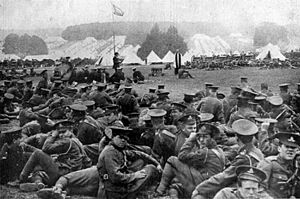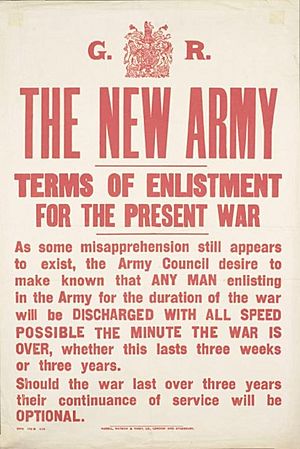Kitchener's Army facts for kids
The New Army was a special part of the British Army formed during World War I. It was also known as Kitchener's Army because Herbert Kitchener, who was the Secretary of State for War, suggested creating it. When the war started in July 1914, Kitchener asked for 500,000 volunteers to join the army.
At first, everyone thought the war would be over quickly. But Kitchener believed it would be a long and tough fight. He wanted to create a huge new army of well-trained soldiers. He hoped these new divisions would help win the war against the Central Powers. Even though some people disagreed, Kitchener pushed his plan forward.
The first major battle where Kitchener's Army fought was the Battle of Loos in September 1915. These new soldiers were also tested in battles like the Gallipoli Campaign and the very difficult Battle of the Somme.
Contents
Joining Kitchener's Army
When Kitchener asked for volunteers, many men were excited to join. Long lines of people formed outside recruitment offices. It was so popular that some groups of friends, neighbours, or co-workers joined together. These were called "Pals' Battalions."
Because so many men joined at once, there were problems. The army didn't have enough uniforms, equipment, or places for everyone to live and train. The government quickly opened more recruitment centres and built temporary camps to help. Almost 2.5 million men volunteered for Kitchener's Army.
By 1916, fewer people were volunteering. News about how terrible the war really was had reached Britain. So, Britain had to start using conscription, which means the government made it a rule that certain people had to join the army. This was similar to what other countries in the war were doing.
The first soldiers who were forced to join arrived in France in late 1916. They helped fill the gaps in the volunteer units, which had lost many soldiers in battles like the Somme. By 1918, many of the British soldiers fighting were conscripts. Some were very young, under 21, while others were older.
Training the New Soldiers

Normally, new soldiers would go to their regiment's base for training. But with so many new recruits, this wasn't possible. Many men trained in their own clothes because there weren't enough uniforms. The army sometimes gave out old uniforms, even red jackets from an earlier war! Some regiments even bought uniforms and boots for their soldiers using money from public donations. New blue uniforms, called Kitchener Blue, were also made.
It was also hard to find enough officers to lead and train all the new soldiers. The army called back officers who had retired or were on leave. Many university graduates or those from special schools who had some military training were made officers right away. As the war went on and many officers were lost in battle, soldiers who showed leadership skills were promoted from the ranks.
The army also struggled to get enough weapons. There were no artillery guns left in Britain for training, so many battalions had to practice with old rifles or even wooden fake guns. By early 1915, the government started to fix these problems. They even used old ceremonial cannons and unfinished modern guns for training.
Changes to the Army
By early 1918, there weren't enough soldiers in France. So, the army decided to make infantry divisions smaller. They reduced them from twelve groups of soldiers (battalions) to nine. The newer units, like those from Kitchener's Army, were often the ones that were broken up. This helped make the divisions in France more similar. By this time, there wasn't much difference between the original Regular Army, the Territorial Force, and Kitchener's New Army.
How Kitchener's Army Was Organized
Kitchener's New Army was made up of several large groups of divisions. Each group was like a small army itself. Here are some of the main groups:
K1 Army Group
- 9th (Scottish) Division
- 10th (Irish) Division
- 11th (Northern) Division
- 12th (Eastern) Division
- 13th (Western) Division
- 14th (Light) Division
K2 Army Group
- 15th (Scottish) Division
- 16th (Irish) Division
- 17th (Northern) Division
- 18th (Eastern) Division
- 19th (Western) Division
- 20th (Light) Division
K3 Army Group
- 21st Division
- 22nd Division
- 23rd Division
- 24th Division
- 25th Division
- 26th Division
K4 and K5 Army Groups
There were also K4 and K5 Army Groups, which included many other divisions. Some of the early K4 divisions were later used to provide replacement soldiers for the first three New Armies. New divisions were then formed and given these numbers.
For example, the K4/K5 Army Group included:
- 30th Division
- 31st Division
- 32nd Division
- 33th Division
- 34th Division
- 35th Division
And a new K5 Army Group was formed later, including:
- 36th (Ulster) Division
- 37th Division
- 38th (Welsh) Division
- 39th Division
- 40th Division
- 41st Division
Images for kids
See also
- List of British divisions in World War I




